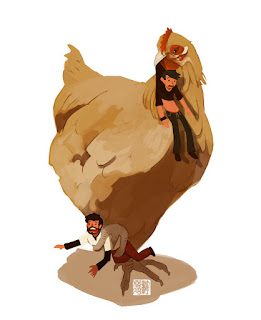Pamola: A weather spirit of Abenaki Mythology that cause cold weather. He is discribed having the head of a moose, the torso of man, the wings and talons of an eagle.
Pandi: A race of giant-eared people with eight fingers and toes, and white hair that turned black with age.
Parandus: They were ox-sized, long-haired, with antlers and cloven hooves, but they can also change shape at will.
Patupairehe: Spirits of the mists and forests of New
Zealand folklore. They have white skin and red hair. They enjoy music and
dancing. There music will lead any mortal into the forest, until their lost.
Pamarindo: Italian goblins with very rude and
antisocial personalities, and have carnivorous appetites.
Pegasus: The legendary winged horese of Greek Mythology. The offspring of Posideon and Medusa, the horse was latter used for the greek heroe Bellephorn.
Penghou: Tree spirits of Chinese folklore. They appear as a black dog with no tail, and its meat can be prepared as food. The essence of a 1,000-year-old tree may evolve into a spirit called Jiafei.
Peri: Small winged faeries from Persian folklore. They enjoy a diet of perfumed air.
Peryton: A hybrid of a deet and eagle. The Peryton casts the shadow of a man until it kills one during its lifetime, at which time it starts to cast its own shadow.
Piasa Bird: A dragon like creature of Native American Algonquian mythology. This creature was reported to sighted in Illinois. The Piasa is being the size of a deer with the body of man covered in scales. It had a long tail ending in a poisonous barb and had the face of a man with red eyes and a green beard.
Pishacha: Flesh eating demons of Hindu Mythology. They have been described to have a dark complexion with bulging veins and protruding, red eyes.
Pixies: Pixies are creatures of Cornish folklore. They are considered to be particularly concentrated in the
areas the downs and moors of Devon and Cornwall. Like sprites and other
different types of English faeries, pixies are often considered
mischievous, but not overtly malevolent creatures of nature. Their most
commonly depicted image is a wingless and pointy-
eared fairy-esque creature
dressed in green.
Pixiu: Awinged lion of Chinese Mythology, they are consitered to be creatures protectors of to practitoners of Feng Shui. The creature seems to project a sense of strength, elegance and mobility. It is said to have a voracious appetite towards only gold and silver.
Phooka: According to legend, the phooka is a
deft shape shifter, capable of assuming a variety of terrifying or pleasing
forms, and may appear as a horse, rabbit, goat, goblin, or dog. No matter what shape the phooka takes, its fur is
almost always dark. It most commonly takes the form of a sleek black horse with
a flowing mane and luminescent golden eyes. If a human is enticed onto a
phook’s back, it has been known to give them a wild ride; however, unlike the kelpie, which will take its rider and dive into the nearest stream
or lake to drown and devour him/her, the phooka will do its rider no real harm.
Plikywiggins: Small
winged humanoids that live among the flowers.
Poltergeist: Invisbile spirits who are responsible for physical disturbances such as loud noises and objects moved around or destroyed. Most accounts of poltergeists describe movement or levitation of objects, such as furniture and cutlery, or noises such as knocking on doors.
Pollo Malingo: Giant man eating chiken
Poleviks: They
look more like bipedal goats than anything resembling a human. They aid in the
growing and harvesting of crops. If they aid with your crops, they
expect excessive payment at the harvest's end. Even today some Polish farmers who wish to have no
trouble with them leave extra grain in the field each week as a libation. This
way they know they will look upon their next year’s crop favorably. Farmers in
the field using sickles are protected because this is an instrument which the
Poleviks fear and will flee from.
Puckwudgies: Goblin like creatures from Native
American folklore. They have been known for causing malice to any mortal they
come in contact with. Such as stealing cloths or tools, causing fires or
killing there victim with poisonous weapons.


















No comments:
Post a Comment